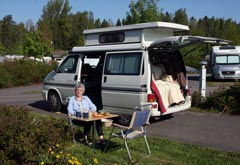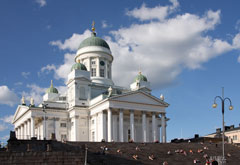|
|
*** FINLAND 2012 - WEEK 3 *** | ||
|
|
|
|
|
|
Late afternoon traffic on the Helsinki Ring Road was congested, slow-moving and intolerant as we joined at the western end to travel around to the far side of Finland's capital city to reach Rastila Camping in the eastern outskirts. Passing through a series of complex junctions, the Ring #1 arched around the northern side of the city to reach the exit for Rastila Camping. Pulling into the campsite reception area brought a heart-sink moment: even in late May it looked crowded - should we have phoned to reserve a place? But we were welcomed with quiet efficiency: yes there was space, but the price was an expensive €27/night including a €4 Scandinavian Camping Card discount. There was however plentiful help without needing to ask: city-plans, metro map and ticket details, and site-wide wi-fi. The huge camping area was rather stark with few trees for shade and surrounded by modern apartments, but the metro station was only 5 minutes walk for access to the city tomorrow.
The following morning in bright sunshine we walked round to the metro station; tickets are an expensive €2.20 but are valid for 1 hour on all forms of city public transport. The stations and trains are spotlessly clean and bright and trains run every 10 minutes (Photo 1 - Metro into Helsinki from Rastila). We followed the 20 minute ride into the centre on the metro-map provided by Rastila Camping, to get off at the Central Railway Station; being such an Art Nouveau monument in its own right, the railway station was the first of Helsinki's sights to be viewed (Photo 2 - Helsinki's Art Nouveau style Central Railway Station). Helsinki was originally founded in 1550 by the Swedes to rival St Petersburg for the Baltic trade, but the port only really began to develop after the construction of Suomenlinna Fortress on one of the offshore islands in 1748. Following Imperial Russia's acquisition of Finland in 1808, a huge fire levelled the city. Tsar Alexander I moved the Grand Duchy's new capital to Helsinki from Turku in 1817 and the city was redesigned by German-born architect Carl Ludwig Engel with grand neo-Classical public buildings. At the turn of the 20th century, many areas of Helsinki were rebuilt in distinctively Finnish Jugendstil Art Nouveau style, and later with independence in 1917 more modern styles inspired by National Romanticism were added to the city's architectural pot pourri. 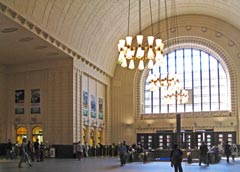
We emerged from the metro up into the grandiose entrance hall of the Rautatieasema (Central Railway Station), a sturdily imposing Art Nouveau structure faced with red granite built in 1919 just after Finnish independence. The stunningly lofty entrance hall (see left) led through to the platforms. The clear glass canopy made the station feel light, airy and clean, with attractive floral decorations and not a miniscule spot of litter in sight; modern double-decker electric trains glided quietly into and out of the platforms. Alongside the Art Deco ticket hall, the station's huge main doors, almost too heavy to open, led out into the busy main street for us to see the full glory of the Art Nouveau façade, decorated with 2 pairs of muscular male figures sculpted from red granite each holding a large spherical glass lantern (Photo 3 - Stone Men Lantern Bearer figures on façade of Helsinki station). Known as lyhdynkantajat (Lantern Bearers) or kivimiehet (Stone Men), these iconic figures have become Helsinki's unofficial emblems, used in animated form in a 2009 TV advertising campaign for VR, Finland's state operated railways. The station's starkly tall clock-tower like some incongruously added afterthought overawed the neighbouring bus station and discretely tucked away Jugendstil National Theatre, a centre of Finnish nationalism in the late 19th century. In front of the theatre, a seated statue portrayed what was believed to be a likeness of Finland's great playwright, Aleksis Kivi who died insane and impoverished in 1872; only later was his work acknowledged and no one knew for certain what he really looked like!
Duly fed and watered, we took a last look up to
the Cathedral from the corner of Senate Square (Photo 9 - Engel's
Lutheran Cathedral dominating Helsinki's Senate Square)
and walked down past the City
Hall (another Engel inheritance) to the dockside Kauppatori open-air market.
Cruise ships moored out in the harbour spilled out marauding hoards of mass
tourists to amble moronically around the market's food stalls which readily
relieved them of their euros. During the early morning, the market is mainly
functional selling fruit, vegetable and fish (Photo 10 - Kauppatori dockside open-air market), but
by the afternoon the stalls
were mostly selling tourist tat - anything from T-shirts to over-priced
reindeer skins. Across the road uniformed guards kept watch over the Presidential
Place, originally designed by Engel for the Tsar, and the presidential flag flew
on the mast above (Photo 11 - Helsinki's Presidential Palace). Nearby on
a prominent rocky hillock set on the islet of Katajanokka separated by a small
canal stood Helsinki's Russian Orthodox Uspenski Cathedral with its distinctive
red and green onion domes (Photo 12 - Russian Orthodox Uspenski Cathedral). Dating from 1868,
its sumptuous interior was decorated with gilded iconostasis and Byzantine
inscriptions on the vaulting (Photo 13 - Interior of Helsinki's Russian Orthodox Uspenski Cathedral).
The following morning being Saturday, the metro
was busier as we again travelled into the city centre. After a stop at the post
office to post our cards we walked around into Mannerheimintie, named after
Finland's wartime military hero Marshal Carl Gustaf Mannerheim, to find His statue sitting on His
horse in His Avenue. Mannerheim's statue stood disdainfully turned away from Kisma modern art gallery surveying the Parliament Building across the broad
boulevard as trams trundled by (Photo 18 - Equestrian statue of Finland's wartime hero Marshal Mannerheim). We crossed to a small park to photograph the
cuboid block-shaped Parliament fronted by 14 pompous pseudo-Corinthian columns
and set aloft on a pediment of tall steps. In 1930 the design in starkly stern
red granite had been intended to symbolise the new Finnish republic's identity
and democratic ideals, but its severely authoritarian lines now seem more in
tune with some of the monstrous architectural creations of Nazi Germany or
Fascist Italy. Reform of the Finnish parliamentary system began even at the tail
end of the Grand Duchy when in 1906 the old Diet of Estates was dissolved in
favour of a unicameral parliament elected by universal and equal suffrage. The
right to vote and to stand as a parliamentary candidate no longer depended on
wealth or social status and was extended to all citizens including women. At the
time it was one of Europe's most radical democratic reforms, some 12 years before the Suffragettes and WW1 forced the same pattern of reform in Britain.
The first Finnish parliament in 1907 included 19 female MPs. After independence
in 1917, an architectural competition decided on J S Sirén's design for the new
Parliament Building which was opened in 1931 (Photo 19 - Finland's Parliament Building).
We had arranged in advance by email to visit the
Finnish Parliament and after passing through the security check, we were met by
our guide, an impish, darting eyed lady, who alternated her detailed
commentary in Finnish and fluent English. It was fascinating listening to
Finnish being spoken, a curious language wildly unlike any other we had
experienced other than Estonian last year. She led us up to the visitors'
gallery looking down into the Parliament's plenary chamber, a vast circular
auditorium topped by a lofty cupola and lit by natural light from the dome's
lantern (Photo 20 - Plenary chamber of
Our guide described the art work of the
parliamentary chamber which was overlooked by an array of 4 nude male statues
and a female coyly concealing her nakedness from the parliamentary assembly
sitting below. We asked the guide about the Finnish Parliament's relationship
with the devolved regional parliaments of Åland and the indigenous Sámi people
in Lapland. Her rather blandly dismissive stock answers were not convincing; we
shall see what alternative views we learn of when we visit the Sámi Parliament
in Inari. After seeing the Members' grandly Art Deco cafeteria, the visit
concluded in the magnificently marble state assembly hall used for official
gatherings. As always, the opportunity to visit our host country's parliament
and learn directly about its democratic working had been a fascinating
experience. On a hot afternoon we walked up Arkadiantkatu to find the church of Temppeliaukion kirkko; no conventional church this, but an underground chamber hewn out of a huge granite outcrop set in a small square amid residential apartment blocks. This curiously Finnish structure created in 1969 is now very much on the tourist trail and thronged with swarming hoards from the cruise ships. From above ground atop the natural granite outcrop, the only visible sign of the underground church is its green copper dome looking like a 1950s sci-fi film flying saucer appearing to have settled here in this quiet residential square (Photo 21 - Underground church of Temppeliaukion kirkko). On entering the underground church, we were amazed at both its size and light airiness, illuminated by the ring of glazed ceiling panels surrounding the copper domed roof. The natural rocks walls of the excavated circular chamber made for a breath-taking combination of man-made structure within the natural underground cavity (Photo 22 - Interior of Temppeliaukion kirkko underground church). Suspend disbelief; this avant garde design concept is well worth seeing.
We concluded our time in Helsinki by taking one of
the cruises around the harbour in order to appreciate the seaward views of the
capital city. This meant a walk back along Mannerheimintie busy with Saturday
afternoon shoppers and the trams passing to and fro (Photo 23 - Saturday afternoon shoppers and trams in Mannerheimintie),
and along through the gardens of Esplanadi to the harbour-side by Engel's City
Hall (Photo 24 - Helsinki's City Hall and the Eteläsatama dock). From the Eteläsatama dock, we joined M/S Doris for a 1½ Back ashore we walked slowly past Engel's City Hall and up a side lane leading back to Senate Square, the view dominated by the outline of the Lutheran Cathedral gleaming in the afternoon sunlight and the full splendour of Engel's Government Palace similarly lit by the western sun (Photo 27 - Helsinki's Lutheran Cathedral). With a last backward glance at Engel's Cathedral standing proudly atop its podium with its plethora of domes and apostolic statues forming a backdrop to the Tsarist era statue in the square below (Photo 28 - Our final view of Helsinki's Senate Square and Lutheran Cathedral), we made our way back to the railway station for our last metro ride back out to Rastila Camping. Again our evening's suppertime peace was disturbed by the intrusive noise of other people's inconsiderately overloud conversations, yapping dogs and televisions. How we longed for peaceful rural campsites again. Camping Rastila close to the metro station had been convenient for visiting Helsinki, but it had been expensive and unduly noisy. Tomorrow we should be driving eastwards, leaving behind the noisy crowds. Follow us in the next edition as we continue our journey eastwards towards the Russian border and into South Karelia and the Finnish lake district. Next edition to be published in 2 weeks
|
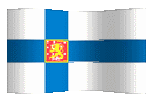
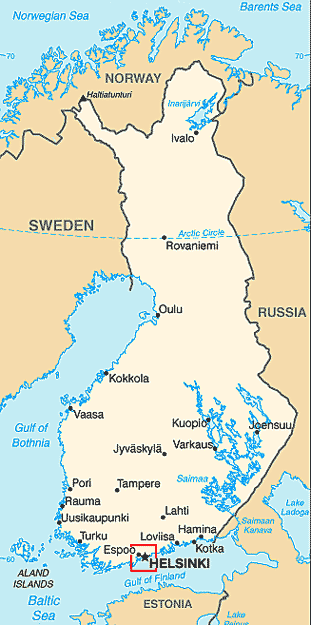 CAMPING
IN FINLAND and LAPLAND 2012 - Helsinki, capital city of Finland:
CAMPING
IN FINLAND and LAPLAND 2012 - Helsinki, capital city of Finland: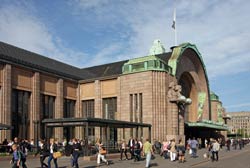 No sooner had we settled in to relax with a
beer after our journey than our peace was broken by the arrival of a gaggle of
inconsiderately noisy Gallics. The irritation of French (or Dutch or even worse
Italian) camping-cars is that they tend to hunt in packs; when 2 or 3 are
gathered together, it's one disturbance too many, especially after the restful
peace of deserted campsites in SW Finland.
No sooner had we settled in to relax with a
beer after our journey than our peace was broken by the arrival of a gaggle of
inconsiderately noisy Gallics. The irritation of French (or Dutch or even worse
Italian) camping-cars is that they tend to hunt in packs; when 2 or 3 are
gathered together, it's one disturbance too many, especially after the restful
peace of deserted campsites in SW Finland.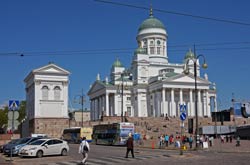
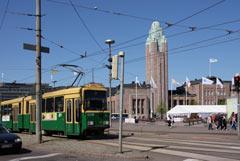 We headed through back streets towards the
University and Cathedral area and suddenly the imposing open space of Senate
Square opened out before us surrounded by the graceful symmetry of C L Engel's
array of neo-Classical public buildings: the Government Palace closing off the eastern end
(Photo 4 - Engel's neo-Classical Government Palace on Senate Square) and
the western end graced by the neo-Classical splendour of the University Main
Building (Photo 5 - Engel's Main neo-Classical building of Helsinki University).
The brilliantly white-faced Lutheran Cathedral with its ornate domes glistened
in the sunlight, and climbing up onto its lofty podium steps gave us a high
viewpoint from which to photograph the square. We were just in time to attend
the lunch-time organ recital, but the Cathedral's starkly bare Lutheran interior
contrasted starkly with the neo-Classical extravaganza of its domed and
Corinthian columned exterior (see right). The Cathedral's high podium also gave a
clear view of what is considered the finest of Engel's neo-Classical designs,
the University Library (Photo 6 - Engel's neo-Classical University Library); the podium's broad steps
provided a vantage point for watching ballet students performing
on a temporary stage down in Senate Square (Photo 7 - Helsinki's Lutheran Cathedral set on its lofty podium steps).
We headed through back streets towards the
University and Cathedral area and suddenly the imposing open space of Senate
Square opened out before us surrounded by the graceful symmetry of C L Engel's
array of neo-Classical public buildings: the Government Palace closing off the eastern end
(Photo 4 - Engel's neo-Classical Government Palace on Senate Square) and
the western end graced by the neo-Classical splendour of the University Main
Building (Photo 5 - Engel's Main neo-Classical building of Helsinki University).
The brilliantly white-faced Lutheran Cathedral with its ornate domes glistened
in the sunlight, and climbing up onto its lofty podium steps gave us a high
viewpoint from which to photograph the square. We were just in time to attend
the lunch-time organ recital, but the Cathedral's starkly bare Lutheran interior
contrasted starkly with the neo-Classical extravaganza of its domed and
Corinthian columned exterior (see right). The Cathedral's high podium also gave a
clear view of what is considered the finest of Engel's neo-Classical designs,
the University Library (Photo 6 - Engel's neo-Classical University Library); the podium's broad steps
provided a vantage point for watching ballet students performing
on a temporary stage down in Senate Square (Photo 7 - Helsinki's Lutheran Cathedral set on its lofty podium steps).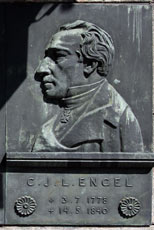 As
city trams trundled past, we walked uphill from Senate Square to find the
elegant 19th century building of the House of Estates (Photo 8 - House of Estates, 19th century governing body of Finnish Grand Duchy),
formerly the meeting hall of
the Diet of Estates (clergy, burgesses and peasantry) which governed the Grand
Duchy
As
city trams trundled past, we walked uphill from Senate Square to find the
elegant 19th century building of the House of Estates (Photo 8 - House of Estates, 19th century governing body of Finnish Grand Duchy),
formerly the meeting hall of
the Diet of Estates (clergy, burgesses and peasantry) which governed the Grand
Duchy
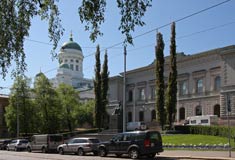 until 1906. On the opposite side of the road stood the equally imposing
Finnish National Bank, backed by the Cathedral's domes. It was time to find
lunch and we headed back past Senate Square to the University to find the
student cafeteria, said to be open to the public for good-value meals. Very
self-consciously we entered the cafeteria foyer, expecting to be asked for
student ID cards but were readily served our lunch along with young
undergraduates.
until 1906. On the opposite side of the road stood the equally imposing
Finnish National Bank, backed by the Cathedral's domes. It was time to find
lunch and we headed back past Senate Square to the University to find the
student cafeteria, said to be open to the public for good-value meals. Very
self-consciously we entered the cafeteria foyer, expecting to be asked for
student ID cards but were readily served our lunch along with young
undergraduates. 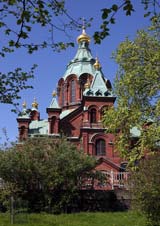 From
the terrace of the Orthodox Cathedral, the view opened out above the
Presidential Palace of the dome of the Lutheran Cathedral (Photo 14 -
Helsinki's Lutheran Cathedral
and Presidential Palace). On the far side of the island, Helsinki's fleet of 5 ice-breakers was moored,
resting here during the summer months but kept busy during the winter clearing
the port's frozen shipping channels (Photo 15 - Helsinki's ice-breakers fleet at their summer moorings).
From
the terrace of the Orthodox Cathedral, the view opened out above the
Presidential Palace of the dome of the Lutheran Cathedral (Photo 14 -
Helsinki's Lutheran Cathedral
and Presidential Palace). On the far side of the island, Helsinki's fleet of 5 ice-breakers was moored,
resting here during the summer months but kept busy during the winter clearing
the port's frozen shipping channels (Photo 15 - Helsinki's ice-breakers fleet at their summer moorings).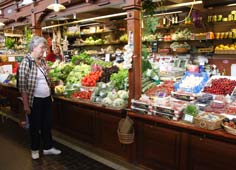 Back around the harbour past the tourist boats
offering harbour cruises, we found the indoor market of Kauppahalli (see right). This
traditional market hall dating from 1888 still had its original dark wood
fittings and was a haven of 19th century elegance with stalls selling fruit and
vegetables, fish, cheeses and bread; it was sheer delight wandering around the
market but prices were more than we cared to pay (Photo 16 - Helsinki's indoor Kauppahalli market).
Nearby trams passed around the cobbled square where the Art Nouveau mermaid
statue of Havis Amanda stood, symbolising the city's rebirth at the turn of the
20th century and scene of drunken May Day revels. The boulevard
parkland-gardens of Esplanadi was clearly the place where Helsinki locals
strolled in the late afternoon sunshine or office workers and students sat on the grass to
eat ice cream; we joined them for a relaxing end to our first day's exploration
of the capital (Photo 17 - Strolling through the parkland boulevard of Esplanadi). Musicians played impromptu
entertainments and shops and high buildings on each side of the boulevard peeped
through the trees' bright green new leaf. At the far end, crowds waited
expectantly for a free out-door show by the renowned Helsinki fashion house
Marimekko to see this summer's latest designs paraded along the catwalk.
Back around the harbour past the tourist boats
offering harbour cruises, we found the indoor market of Kauppahalli (see right). This
traditional market hall dating from 1888 still had its original dark wood
fittings and was a haven of 19th century elegance with stalls selling fruit and
vegetables, fish, cheeses and bread; it was sheer delight wandering around the
market but prices were more than we cared to pay (Photo 16 - Helsinki's indoor Kauppahalli market).
Nearby trams passed around the cobbled square where the Art Nouveau mermaid
statue of Havis Amanda stood, symbolising the city's rebirth at the turn of the
20th century and scene of drunken May Day revels. The boulevard
parkland-gardens of Esplanadi was clearly the place where Helsinki locals
strolled in the late afternoon sunshine or office workers and students sat on the grass to
eat ice cream; we joined them for a relaxing end to our first day's exploration
of the capital (Photo 17 - Strolling through the parkland boulevard of Esplanadi). Musicians played impromptu
entertainments and shops and high buildings on each side of the boulevard peeped
through the trees' bright green new leaf. At the far end, crowds waited
expectantly for a free out-door show by the renowned Helsinki fashion house
Marimekko to see this summer's latest designs paraded along the catwalk.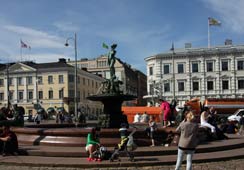 Weary
after a full day of city-plodding, we made our way back along Mannerheimintie,
the main shopping street, past Stockmanns, Scandinavia's largest department
store, and descended into Tunneli, the underground shopping precinct
with led
back to the railway station to relax with beers at the bar-terrace outside the
station joining other locals enjoying post-work or pre-train drinks. At 6-30 we
returned to the metro to catch a train back out to
Weary
after a full day of city-plodding, we made our way back along Mannerheimintie,
the main shopping street, past Stockmanns, Scandinavia's largest department
store, and descended into Tunneli, the underground shopping precinct
with led
back to the railway station to relax with beers at the bar-terrace outside the
station joining other locals enjoying post-work or pre-train drinks. At 6-30 we
returned to the metro to catch a train back out to 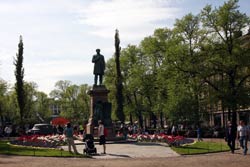 Rastila Camping after a
satisfyingly productive first day in Helsinki.
Rastila Camping after a
satisfyingly productive first day in Helsinki.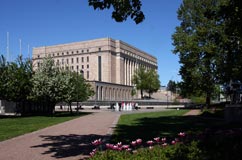
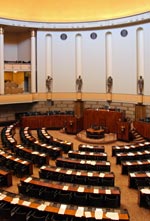 Finland's Parliament, the Eduskunta). Her enthusiastic commentary described the building's history,
features and art work and the workings of the Finnish Parliament, the Eduskunta.
There are 200 members (42% of whom are currently female) elected by PR for a 4
year term. MPs elect one of their number as Speaker. The State President is
elected by the people in separate presidential elections, and now can serve a
maximum of two 6 year terms. This curtailment of presidential powers followed
the tensions between parliament and president during Urho Kekkonen's 26 year
authoritarian presidency (1956~82). Much play is now made of the people's power
in electing parliament, with the State President now more of a symbolic
figurehead whose powers are carefully curtailed by the Eduskunta. Finland's
parliament currently has 8 main parties and, in common with other Nordic
countries, governments tend to be formed by coalitions. Parliament elects the
Prime Minister from the leader of the majority party, and former Speakers
regularly go on to be elected State President.
Finland's Parliament, the Eduskunta). Her enthusiastic commentary described the building's history,
features and art work and the workings of the Finnish Parliament, the Eduskunta.
There are 200 members (42% of whom are currently female) elected by PR for a 4
year term. MPs elect one of their number as Speaker. The State President is
elected by the people in separate presidential elections, and now can serve a
maximum of two 6 year terms. This curtailment of presidential powers followed
the tensions between parliament and president during Urho Kekkonen's 26 year
authoritarian presidency (1956~82). Much play is now made of the people's power
in electing parliament, with the State President now more of a symbolic
figurehead whose powers are carefully curtailed by the Eduskunta. Finland's
parliament currently has 8 main parties and, in common with other Nordic
countries, governments tend to be formed by coalitions. Parliament elects the
Prime Minister from the leader of the majority party, and former Speakers
regularly go on to be elected State President.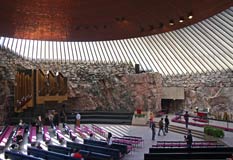
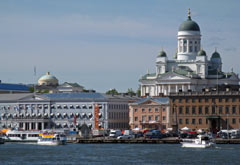 hour tour
of Helsinki's harbour and archipelago of off-shore islands. As the boat pulled
away from its moorings, the magnificent panorama of Helsinki's waterfront backed by
the Lutheran Cathedral opened before us (Photo 25 - Panorama of Engel's architecture at Helsinki's waterfront). Dwarfed by the huge
ferries moored here for the regular crossings to Tallinn and Stockholm, the boat
crossed the harbour and swung around to pass the marinas and waterside
cafés on Helsinki's southern peninsula. Looking back towards Helsinki, the
magnificent panorama of the city's skyline with its 2 cathedrals fully justified
Helsinki's epithet of 'The White City' when seen from this seaward approach (Photo 26 - Helsinki's skyline, the 'White City' viewed from the harbour). The
cruise continued across open waters to pass by the Suomenlinna Fortress Island,
constructed by the Swedes in 1748 and reinforced later by the Russians. During
the Finnish Civil War fought between right and left wing factions following the
country's gaining independence in 1917, 12,000 Reds were held in a notorious
prison camp on the island. The boat passed along the main shipping channel used
by ferries entering or leaving Helsinki's port, to Finland's outer seaward
gateway and swung around between islands to return to the calmer waters of the
harbour along by the fleet of 5 ice breakers we had seen from the landward side
yesterday and back to the moorings by the dockside market which was just packing
up. This had been a worthy conclusion to our 2 days in Helsinki, giving us the
chance of seeing the wonderful seaward view of the capital city.
hour tour
of Helsinki's harbour and archipelago of off-shore islands. As the boat pulled
away from its moorings, the magnificent panorama of Helsinki's waterfront backed by
the Lutheran Cathedral opened before us (Photo 25 - Panorama of Engel's architecture at Helsinki's waterfront). Dwarfed by the huge
ferries moored here for the regular crossings to Tallinn and Stockholm, the boat
crossed the harbour and swung around to pass the marinas and waterside
cafés on Helsinki's southern peninsula. Looking back towards Helsinki, the
magnificent panorama of the city's skyline with its 2 cathedrals fully justified
Helsinki's epithet of 'The White City' when seen from this seaward approach (Photo 26 - Helsinki's skyline, the 'White City' viewed from the harbour). The
cruise continued across open waters to pass by the Suomenlinna Fortress Island,
constructed by the Swedes in 1748 and reinforced later by the Russians. During
the Finnish Civil War fought between right and left wing factions following the
country's gaining independence in 1917, 12,000 Reds were held in a notorious
prison camp on the island. The boat passed along the main shipping channel used
by ferries entering or leaving Helsinki's port, to Finland's outer seaward
gateway and swung around between islands to return to the calmer waters of the
harbour along by the fleet of 5 ice breakers we had seen from the landward side
yesterday and back to the moorings by the dockside market which was just packing
up. This had been a worthy conclusion to our 2 days in Helsinki, giving us the
chance of seeing the wonderful seaward view of the capital city.